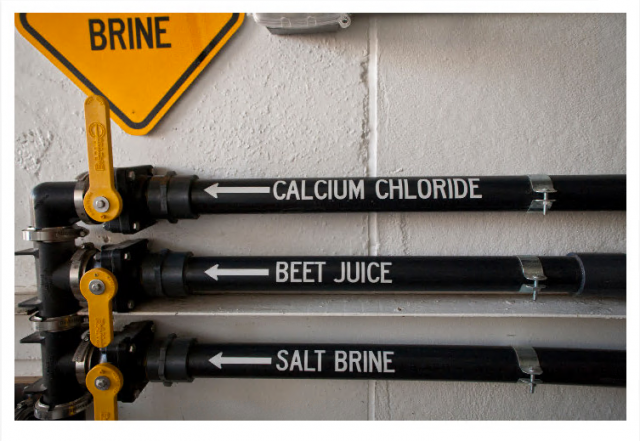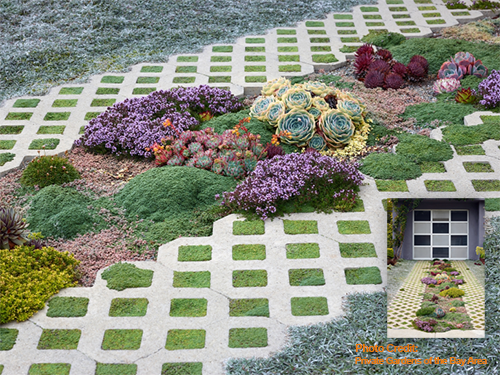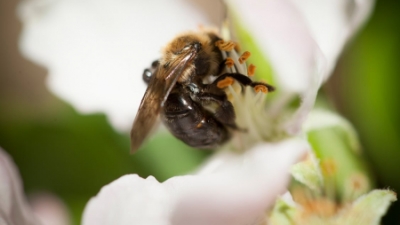 Honey bees play a vital role in New York State’s agriculture economy. Each year, thousands of bee colonies are used throughout the state to pollinate more than $300 million worth of agricultural crops such as apples, grapes, and pumpkins. New York is home to more than 60,000 of the bee colonies used each year, while additional colonies are shipped in from other regions of the country or even foreign countries to make up the remainder. The Department inspects bee colonies and monitors their movement to ensure that the state is protected from potential problems in its honey bee population. (NY AG and Markets)
Honey bees play a vital role in New York State’s agriculture economy. Each year, thousands of bee colonies are used throughout the state to pollinate more than $300 million worth of agricultural crops such as apples, grapes, and pumpkins. New York is home to more than 60,000 of the bee colonies used each year, while additional colonies are shipped in from other regions of the country or even foreign countries to make up the remainder. The Department inspects bee colonies and monitors their movement to ensure that the state is protected from potential problems in its honey bee population. (NY AG and Markets)
For more information and best management practices visit:https://agriculture.ny.gov/plant-industry/honey-bee-health
Make 2021 a Conservation New Year
Recycle the Christmas Tree
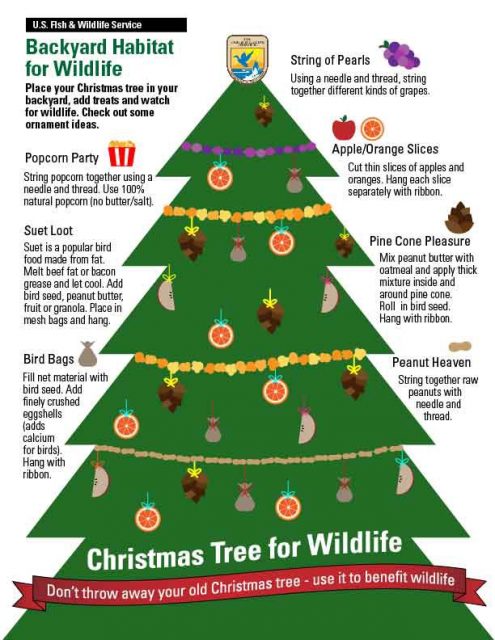
One of the other benefits of a real Christmas tree is the different ways you can recycle it at the end of the season. The most common use for your tree is to make mulch or compost out of it. Whether it’s with the woodchips or needles, mulch is a great way to keep your yard trees healthy and moist during the cold winter season. Pine needles are full of nutrients that enhance the PH of your soil if it is more alkaline and allows your soil to breathe without becoming dense and compacted. Be sure to douse your pine needles with water and mix well in your compost pile. Other ways to upcycle:
Insulate the Garden
Try cutting off the branches of your tree and lay them on your garden bed, the boughs will protect your plants from winter freezes and spring thaws. By laying them on your garden, you’re giving your plants a steady temperature for the cold months. The limbs also work well as a garden edge.
Feed the Birds
Secure the tree outside in your yard in a stand, or with stakes and twine. and hang bird feeders to attract birds and watch your tree evolve into a bird sanctuary. Other critters will soon follow as they nest in the branches of the tree. That used tree will make an excellent home for the birds for the rest of the winter. Make sure it’s free of all ornaments and tinsel. Provide sustenance for your bird friends as well by decorating the tree with strands of popcorn, suet, or pinecone bird feeders.
Make a Home for Fish
If you have a backyard pond, use your tree to create fish habitat. Sink your old tree into the water to creates a welcoming habitat for fish. The branches give them a place to take cover. Just make sure the tree is completely free of tinsel or flocking material that might harm wildlife.
Every little thing YOU do really makes a difference, these small changes cumulatively over time can have a significant benefit to our environment, make 2021 a Conservation New Year.
Infographic: US Fish and Wildlife Service
Make 2021 a Conservation New Year
Holiday Food Composting
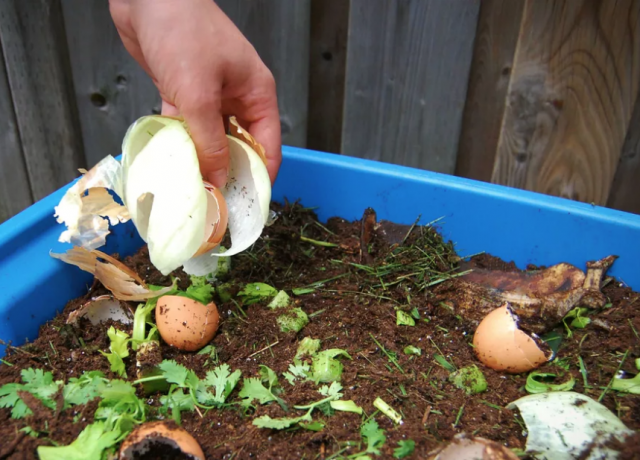 Composting is simply the process of organic material decomposition.
Composting is simply the process of organic material decomposition.
Every holiday dinner we seem to have an abundance of leftovers, often these food leftovers are thrown out or left to spoil. According to Cornell University, there are nearly 38 million tons of wasted food in the United States. Composting is simply the process of organic material decomposition. If we composted many of the things we throw away, such as kitchen scraps, grass clippings, leaves, and other landscape debris, we could divert 20 to 30 percent of the trash currently going into landfills.
By composting these materials, we can reduce the amount of waste we generate and produce organic matter and nutrients for our garden, landscape, and yards. Every garden benefits from the addition of compost because it supplies many of the nutrients plants need. Composting also improves the soil’s physical characteristics, increases soil capacity to hold water and nutrients, and increases soil aeration.
In general, you should have about four times as many browns as greens. If your goal is simply to avoid sending organic matter to the landfill and the compost is an afterthought, then you don’t need to worry about it too much. If your bin gets wet and smelly, add more browns and cut back on the greens for a while, then give it a turn. If the contents of your bin aren’t breaking down, add some greens, turn it, and it should start turning into compost again. To turn the compost easily, give the bin a shake every one to three days. This blends in air and distributes moisture, creating the perfect environment for the materials to decompose.
Compost: fruits, vegetables, grains, bread, unbleached paper napkins, coffee filters, eggshells, meats, and newspapers can be composted. Don’t add meat, bones, dairy, whole eggs (shells are okay), grease, or other animal-based scraps. These can develop pathogens as they decompose in the compost bin, causing odors that attract rodents and other pests. Never add solid waste from pets.
Every little thing YOU do really makes a difference, these small changes cumulatively over time can have a significant benefit to our environment.
Photo Credit: The Spruce / Cori Sears
Make 2021 a Conservation New Year
Road salt can harm the environment
Highway ditches, marshes, streams, bays, and lakes lie alongside many of the roads and highways that zigzag across North America. Plants and animals inhabit these water bodies and can be exposed to many of the substances we put on those roads, including road salt.
Although rock salt may help keep roads safe it can also have serious, negative effects on aquatic ecosystems.
At high concentrations, salt can be fatal to some aquatic animals. Salt can also change the way the water mixes and lead to the formation of salty pockets near the bottom of lakes, creating biological dead zones. The USGS pinpointed road as toxic to aquatic life, and even low concentrations can produce harmful effects in freshwater ecosystems. High chloride levels in water can inhibit aquatic species’ growth and reproduction, impact food sources. In a recent study, researchers found that 37 percent of the drainage area of the contiguous United States has experienced an increase in salinity over the past 50 years, citing road salt as the dominant source in colder, humid regions of the northeastern United States.
Try these alternatives
Sand: – Although sand is not capable of actually reducing the freezing temperature of the water and cannot melt snow and ice, it is still a great alternative to traditional rock salt. The grainy nature of sand allows for excellent traction. Sand is completely natural and will not cause any damage to your property. In addition to this, sand does not form a brine with frozen snow and ice, so less material is needed over time. This is also significant savings.
Beet juice – After sugar is extracted from sugar beets, the resulting waste water is usually flushed down the drain. But more places around the world are mixing this beet juice with their de-icing cocktails for more effectiveness. Using beet juice mixed with salt reduces the amount needed. It’s also biodegradable and less corrosive. The concentration of carbohydrates in the liquid reduces its freezing point to well below -20 C. When mixed with salt, it makes it stick to the ice, which reduces bouncing and scattering of salt rocks when cars drive over it.
Calcium magnesium acetate (CMA) – CMA is formulated from dolomitic lime and acetic acid. It is effective to a temperature of ~0° F, but effectiveness decreases below 20° F. Like rock salt, it is generally available in granule or pellet form. There is some concern about its oxygen demand as it degrades in water, but a USGS study in Oregon found no negative water quality impacts from roads treated with CMA. Other acetate-based de-icers include Sodium Acetate and Potassium Acetate.
Ashes – For those with a wood-burning fireplace, ashes are a great option. They provide a lot of traction and absorb sunlight, so will melt ice quickly on a sunny day
Pet Safe –Pet-safe commercial deicers are designed to melt ice without harming pets. “Pet-safe” deicers are typically made with an ingredient called urea. Urea is less toxic than other deicing ingredients, but it can still cause issues if not processed specifically for pet safety. Remember to always check the label; the product should be salt- and chloride-free and labeled as child and pet-safe. If it’s not safe for kids, it’s not safe for your dog.
Every little thing YOU do really makes a difference, these small changes cumulatively over time can have a significant benefit to our environment.
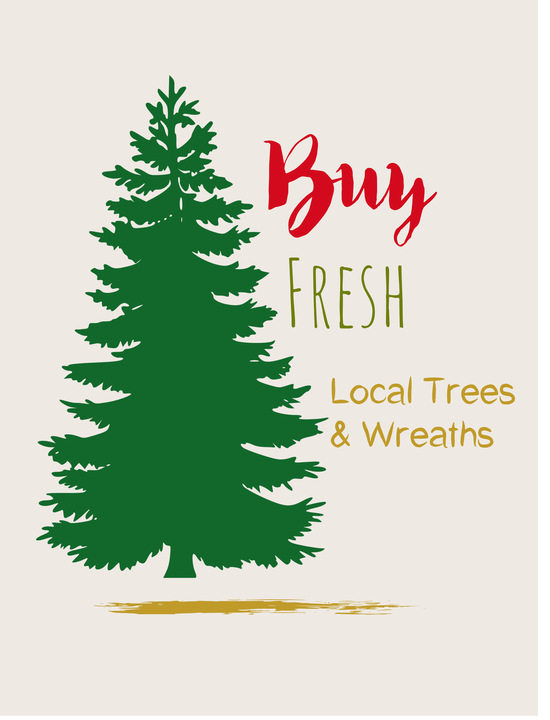 Make 2021 a Conservation New Year
Make 2021 a Conservation New Year
Fresh cut local Christmas Tree.
This weekend many are out shopping for the holiday Christmas Tree. And while most people think it’s bad to cut a live holiday tree. Instead, they may buy an artificial tree made of plastic or other synthetic material. And think because it can be reused year after year, it saves real trees. But not so, according to the Nature Conservancy; when natural trees are harvested for sale, there are more than ten times as many left standing! Out of the 350-500 million growing on tree farms across the U.S., only 30 million trees are harvested for Christmas each year.
Buying real trees will help keep tree farms in business – and in turn, keep their lands covered in the healthy forest habitat that wildlife depends on to survive. In addition, Christmas tree farms provide many of the same benefits as community trees and forests; cleaning the air and water, removing carbon, stabilizing soil, and more.
When purchasing a tree look for the NYS Grown and Certified label. Visit NY Grown and Certified producers @ NYS Ag & Markets
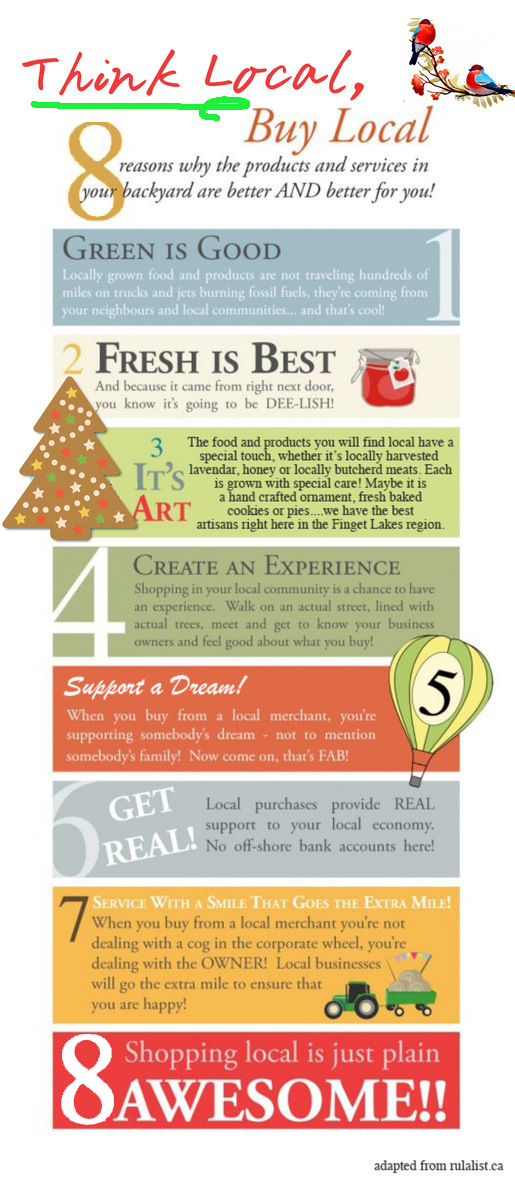 What’s your New Year’s resolution? Make 2021 a Conservation New Year?
What’s your New Year’s resolution? Make 2021 a Conservation New Year?
Let’s start by shopping locally.
When we buy from independent, locally owned businesses a significantly greater portion of our money is then recycled back through our local economy — to make purchases from our friends’ businesses, to aid our neighbors in need, and to support our local farms , when you personally know the people behind the business where you’re buying local products and services, you enjoy a connection you would not otherwise have.— ultimately strengthening the base of our whole community. One added benefit; shopping local conserves energy and resources, for example; less gas for travel. Additionally, local businesses often have a smaller carbon footprint than larger companies.
Here are a few examples of buying local:
- Purchasing locally grown Christmas Trees and handmade wreaths support our farmers and is good for the environment
- Buy locally farmed and butchered meat and poultry, there are many producers in the area
- Gift certificates from local restaurants, especially this year, when many local businesses have limited capacity, a gift certificate supports their future
- Homemade cookies and fresh apple and pumpkin pies from local merchants, many small, family-owned bakeries buy ingredients and various products from other local businesses
- Fingerlakes wines are considered some of the best in the world many producers have websites to order
- Honey and honey products, Wayne County is home to many beekeepers
- CSA certificates, many sustainable farms have Community-Supported Agriculture programs, why not purchase for a friend?
- Pottery and craft items, ask friends and neighbors for local artisans, many work from their homes, and even sell on Etsy!
- Alpaca products are warm — consider a local farm for those hats and scarfs
- Purchase a Forever Green Tree & Shrub sale gift certificate! for 2021
If you are on Facebook, visit Find your Farmer in Western NY or for NY Grown and Certified producers visit NYS Ag & Markets
It’s Fall! The garden produce is harvested, and leaves are changing color and tumbling from the trees—and that means fall cleanup in the yard and garden.
For many people fall cleanup means cutting all the seed heads and stems off the flowers and raking up all of the leaves. A tidy garden and yard are what many people strive to achieve. Everything clipped back, leaves raked and removed, messy piles of branches put in the green bin for pick up. This tidiness may look nice to us, but it is not good for all of the small creatures that live in and around your property.
Out of sight often means out of mind for people and fall is a time when you do not see the bees, butterflies, and other beneficial insects that were flitting around your flowers all summer. Where do these insects go when they are not visiting your garden? Some do migrate—like the monarch butterfly, flying south to overwinter in trees in Mexico or along the California coast—but the vast majority spend their entire life in and around your property. Many of our native solitary bees have laid eggs and provisioned nests in soil or in standing dead trees or hollowed-out branches where the young are pupating. Bumblebee queens have found areas to overwinter under branches, in rock walls, and in other relatively dry, snug places.
Many species rely on fallen leaves for cover and to insulate them from the elements. Depending on the species, butterflies and moths spend the winter as eggs, caterpillars, pupae, or adults. Great spangled fritillary and wooly bear caterpillars tuck themselves into a pile of leaves for protection from cold weather and predators. Red-banded hairstreaks lay their eggs on fallen oak leaves, which become the first food of the caterpillars when they emerge. Luna moths and swallowtail butterflies disguise their cocoons and chrysalis as dried leaves, blending in with the “real” leaves. There are many such examples.
Beyond butterflies, bumble bees also rely on leaf litter for protection. At the end of summer, mated queen bumble bees burrow only an inch or two into the earth to hibernate for winter. An extra thick layer of leaves is welcome protection from the elements. There are so many animals that live in leaves: spiders, snails, worms, beetles, millipedes, mites, and more—that support the chipmunks, turtles, birds, and amphibians that rely on these insects for food.
Leave the leaves does not mean ignoring them and leaving them where they fell. You can move them to places in your yard where they are out of the way, will not kill your turf, and will still help wildlife. A thin layer of leaves can actually help turf—but too much will kill the grass. Consider raking leaves into areas around trees, or use them as winter mulch for perennials or to cover garden beds. Leaving a thick layer of leaves in garden beds helps minimize weed problems early in the spring and can be a great soil amendment.
#leavetheleaves
This article is an abbreviated version of an article posted by Scott Hoffman Black of the Xerces Society, to read the full article click here.
Got the Winter Blues Waiting for the Forever Green Tree Sale … why not get a head start ?
Yes! You can winter sow annuals and perennials. The sowing of seeds in winter is a very old technique. Winter sowing is the process of setting out seeds in containers and leaving them until they emerge in the spring. These containers act as tiny ‘greenhouses’ that protect the seed from the harsher weather but allowing enough cold to help them toughen up over the winter months. Recycled containers work best; some of the most popular include milk jugs, plastic liter bottles aswell as foil-and-plastic take-out containers. Make sure the container can handle freezing and thawing.
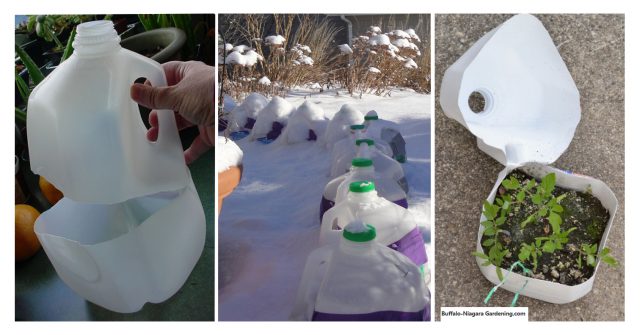
The example shown is the use of a milk jug that acts as mini greenhouses, allowing the seeds to experience the chill of winter in a controlled environment. When the temperature warms enough, the seeds germinate and start to grow on their own. By the time the soil in the planting beds has warmed, the seedlings are ready to transplant out.
🌿Alcea (Hollyhock) ‘Camois Rose’ rosy-pink
🌿Alcea ‘Apple Blossom’ pale-pink
🌿Aquilegia (Columbine) ‘Alpina’ blue
🌿Aquilegia ‘Scarlet’ or mixed
🌿Campanula (Bellflower) ‘Champion Pink’
🌿Centaurea cyanus (Bachelor Buttons)
🌿Consolida (Larkspur) ‘Galilee Blue Double’
🌿Delphinium grandiflorum ‘Blue Mirror’
🌿Digitalis purpurea (Wild Foxglove)
🌿Lupinus (Lupine), ‘Russell Hybrids Mix’
🌿Nepeta ‘Pink Dreams’ pink
🌿Oenothera lamarkiana yellow (Evening Primrose)
🌿Platycodon (Balloon Flower) ‘Sentimental Blue’ t
🌿Chamomile
🌿Chives
🌿Cilantro
🌿Dill
🌿Flax
🌿Hyssop
🌿Kale
🌿Marjoram
🌿Oregano
🌿Parsley
🌿Sage
🌿Spinach
🌿Thyme
🌿Thymus serpyllum (Creeping Thyme)
In the wild, seed dormancy is usually overcome by the seed spending time in the ground through the winter and having it’s hard seed coat softened up by frost and weathering action. By doing so the seed is undergoing a natural form of “cold stratification” or pretreatment. This cold moist period triggers the seed’s embryo; its growth and subsequent expansion eventually break through the softened seed coat in its search for sun and nutrients. Although there may be a better germination rate if some seeds are started indoors, there are seeds that need to experience cold, damp conditions to sprout. The label on Parsley as an example advises the seeds to be placed in the freezer for a few weeks, for quicker germination. The reason for this is to simulate stratification, but you can force these earlier in containers outside.
Step by Step
#1 Clean containers — Wash out your jugs and discard the tops. The open-top provides an air vent for your seeds.
#2 Cut containers — If not using containers with hinged lids, stick a serrated knife into the side of the jug, lay it on its side and cut all the way around, leaving about 1.5”
#3 Create air holes — Use a sharp object to poke holes around the bottom of the container for drainage, this is very important. If you don’t make drainage holes, your seeds will drown!
#4 Add soil — Fill the bottom of the container with about 2” of soil mix. Either use regular soil from a garden center or mix it with seed potting soil, humus or homemade compost.
#6 Seal the container — seal the cut edges of the bottle or container with light-colored duct tape. Leave the top open.
#7 Label containers — use a wooden stick that is large enough to write on and pop it into the soil, through the top of the bottle, or mark with duct tape across the container.
#8 Set out and leave! — set out the jugs in a spot that will get the winter sun. Do not leave them undercover, it is important the seeds experience all the weather conditions as they would in nature.
Tips from the National Christmas Tree Association.
 After the holidays, don’t throw your real Christmas tree in the trash or set it on the curb. Real Christmas trees are biodegradable, which means they can be easily reused or recycled for mulch and other purposes.
After the holidays, don’t throw your real Christmas tree in the trash or set it on the curb. Real Christmas trees are biodegradable, which means they can be easily reused or recycled for mulch and other purposes.
Why Not Recycle Your Real Christmas Tree?
Here are some recycling options and tips on what to do with your tree after the holidays. Every community is different, but in general, you have these options
- Soil erosion barriers: Christmas trees can make effective sand and soil erosion barriers, especially for lake and river shoreline stabilization.
- Fish feeders: Sunk into private fish ponds, trees make an excellent refuge and feeding area for fish.
- Bird feeders: Place the Christmas tree in the garden or backyard and use it as a bird feeder and sanctuary. Fresh orange slices or strung popcorn will attract the birds and they can sit in the branches for shelter. (Make sure all decorations, hooks, garland and tinsel strands are removed). Eventually (within a year) the branches will become brittle and you can break the tree apart by hand or chip it in a chipper.
- Mulch: A Christmas tree is biodegradable; its branches may be removed, chipped, and used as mulch in the garden.
- Paths for hiking trails: Some counties use shredded trees as a free, renewable and natural path material that fits both the environment and the needs of hikers.
- Living, rooted trees: Get a rooted (ball and burlap or containerized) tree and plant it in your yard. (It’s a good idea to dig the hole in the late fall while the soil is still soft, then plant the tree into that hole immediately after Christmas.) Living trees have a better survival rate in mild climates.
How to Make a Christmas Tree Bird Feeder
A Repurposed Christmas Tree Bird Feeder from Garden Answer
Important: Never burn your Christmas tree in a fireplace or wood stove.
Grass or block pavers, or grow-through pavers—are an alternative to traditional asphalt that can be made from concrete or recycled plastic. The open cells in the paver system allow grass to grow through them making them eco-friendly. Applications include driveways, walkways, crossovers on medians, boat launching ramps, fire lanes, and even RV and boat parking lots.
Creative Grass Paver Driveway The example shown is the center strip of a fully functioning ribbon driveway which showcases a variety of succulents and thymes. Although a portion of the garden is necessarily hidden when the car is in residence and occasionally a flower will get decapitated when an auto pulls in, this complex assemblage of succulents provides a startling pop of beauty in a totally unexpected place!
.
What Are The Benefits?
-
- Paver systems help to reduce stormwater runoff and filter out pollutants. Stormwater runoff on a regular pavement can pick up oil and other road pollutants and washes the toxic mess into rivers, bays, and streams.
- Pavers also absorb water, reducing or slowing down the water that races over the pavement in a rainstorm, preventing erosion.
- Grass pavers recharge groundwater. Those spots of grass allow rain to soak into the ground, putting it back into aquifers.
- Through the magic of transpiration, porous pavers will keep the air around your driveway cooler!
Be creative. Paver designs come in many shapes and sizes. You can even create your own design.

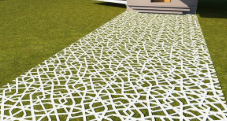
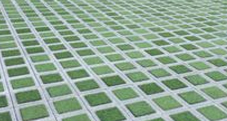
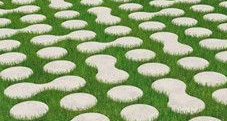
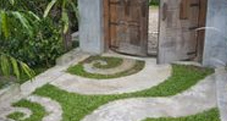
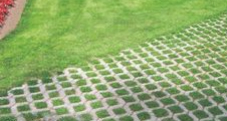
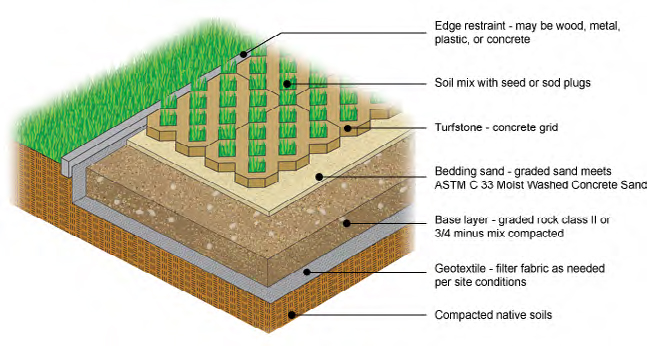
Journal of Civil & Environmental Engineering

